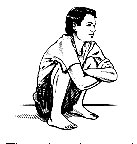Squatting Position

The squatting position is a resting position and therefore is an end in itself. Most indigenous people have squatted and the few remaining indigenous cultures still do, as do some people in Asia. 'Western' people do not not squat and are believed by some to be incapable of squatting. The benefit of squatting in childbirth and defecation is well understood and documented, but will not be described here.
Children when very young squat. We are all born with 'squatting facets' on our tibia and femur, but most Westerners lose these facets very early through disuse. The value of regaining the ability to squat lies in it role as a complete mark of flexibility and alignment. If a person is not flexible, not lengthened, and not aligned 'enough' they will not feel balanced. The innate desire to feel balanced is a call to all the body parts to 'fall in line'.
In casual use, the word squatting is sometimes used to describe a position in which a person has the knees bent but the heels are well up off the ground and the knees are spread far apart. This is position perhaps better termed a crouch. While a crouch may represent and intermediate point in regaining flexibility, it should not be a stopping point. A real squat is illustrated in the drawing above: feet are flat and together, knees are together, the lower back is long.
It is not really necessary to give instructions on how to squat--the illustration is sufficient. However, it may be take quite sometime with other exercises before it is practical to attempt a squat at all. If attempted too early, squatting can hurt knees--pain should be a guide. The greatest single impediment may be an ankle that cannot dorsiflex enough. A useful exercise is the Half Squat, described below.
Variation: Half Squat:.Start by kneeling on a reasonably padded surface. Lift one foot up and place it, sole against the floor, next to the other leg about eight inches behind the knee of the other leg. Try letting the haunch of this side rest against the back of the ankle, and also try letting that side of the torso rest against the upper thigh. Do not twist. Try extending both arms straight out forward, and reach with the arms. starting from the shoulder blades. At the same time try lowering the buttocks closer to the floor without moving the rest of the torso. Then try rocking back and forth to loosen ankle. Repeat movements on other side.
Rationale: To increase grounding, intestinal motility, and lower back length. As an antidote to psychological upward displacement.
Source: Traditional. F. M. Alexander, of the Alexander Method, was one famous proponent of squatting.